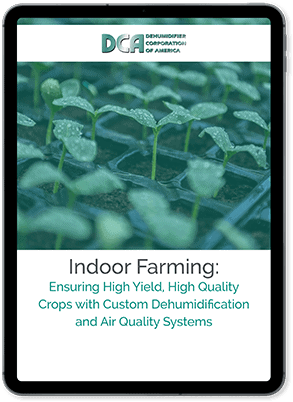With the continued legalization of marijuana across the United States and Canada, cannabis growers are finding that their profit margins have begun to shrink. Rising competition from new cannabis growers has forced established suppliers to drive their prices down, leaving many wondering where they can make up for lost revenue.
Reducing their energy consumption could be the solution. Recent studies show that energy costs account for 20% to 50% of an indoor growhouse’s overhead. In their article on energy use in the cannabis industry, Jesse Remillard and Nick Collins note that air conditioning, dehumidification equipment, and lighting dominate the electric load used by indoor farming operations.
With those findings in mind, Remillard and Collins stress that indoor growhouses can significantly lower their energy costs by optimizing space and installing LED grow lights and dehumidification equipment. At Dehumidifier Corporation of America (DCA), we completely agree. Taking control of your energy use with appropriate investments in efficient equipment available will ultimately pay for itself over time, helping you keep pace in an evolving marketplace.
Why You Must Control Your Space
 To grow cannabis that meets medical quality standards, indoor growhouses must be outfitted with equipment that wards off pests, mold, and mildew while promoting growth. To provide a safe environment for cannabis crops to grow, indoor farmers must control these three conditions:
To grow cannabis that meets medical quality standards, indoor growhouses must be outfitted with equipment that wards off pests, mold, and mildew while promoting growth. To provide a safe environment for cannabis crops to grow, indoor farmers must control these three conditions:
- Temperature
- Space
- Humidity
Failing to regulate one or more of these factors will weaken the crop’s quality or kill it altogether. To provide an ideal growth environment for cannabis plants, you’ll need to focus on the following:
Lighting
This is the single most important factor in any indoor farm. Since plants rely on light for photosynthesis, they cannot grow without it. However, poor lighting can also drastically increase energy costs and cut into an indoor grow house’s profit margin.
Many operations don’t want to invest in LED grow lights because of their greater up-front costs. However, LED lights will pay for themselves fairly quickly and LED’s energy efficiency will contribute to lower total energy costs in the long-term. In fact, most industrial LED lights can reduce energy use by 40% or more over traditional HID lighting fixtures.
Dehumidification and Air Conditioning
Moisture constantly exits plants through leaves and stems in a process called transpiration. The increased moisture in the atmosphere can complicate efforts to maintain the ideal humidity level of an indoor grow house. Cannabis requires humidity to remain between 50% and 60%. Any more and growers risk mold or mildew; any less and crops will dry out.
In addition to controlling humidity, the ambient temperature must stay between 70° and 80° F. Traditional operations have used closed-ventilation systems and HID lights to control humidity and temperature, but these designs require a lot of power. To make your indoor grow house energy efficient, it’s crucial to take HVAC systems into account and make sure that designs are optimized for your particular space.
Failing to properly plan for your space will leave you adding cooling or dehumidifying equipment piecemeal, which will ultimately drive up energy costs until they get beyond your control. At this point, you’ll need to rethink your HVAC systems and start over, so it’s best to focus on an optimal design from the outset.
According to Remillard and Collins, there are two best practices for optimizing your energy consumption. The first is to use outdoor air economized through a filter or dry cooling tower and the second is to use air-to-air heat exchangers to dehumidify your air. Either of these set-ups should help you control energy costs but are not considered optimal for maximum production.
Ask an Expert

As a cannabis grower, you want to get down to what you do best: raising a quality crop. At DCA, we help you achieve that goal by providing the products and services you need to establish an optimal growth environment in your indoor farm. With more than two decades of experience in dehumidification, our engineers and technicians are experts at identifying potential problems and helping you design a dehumidification system that’s optimized for your facility.
To learn more about our indoor air quality equipment and installation services, download our Indoor Farming eBook.





